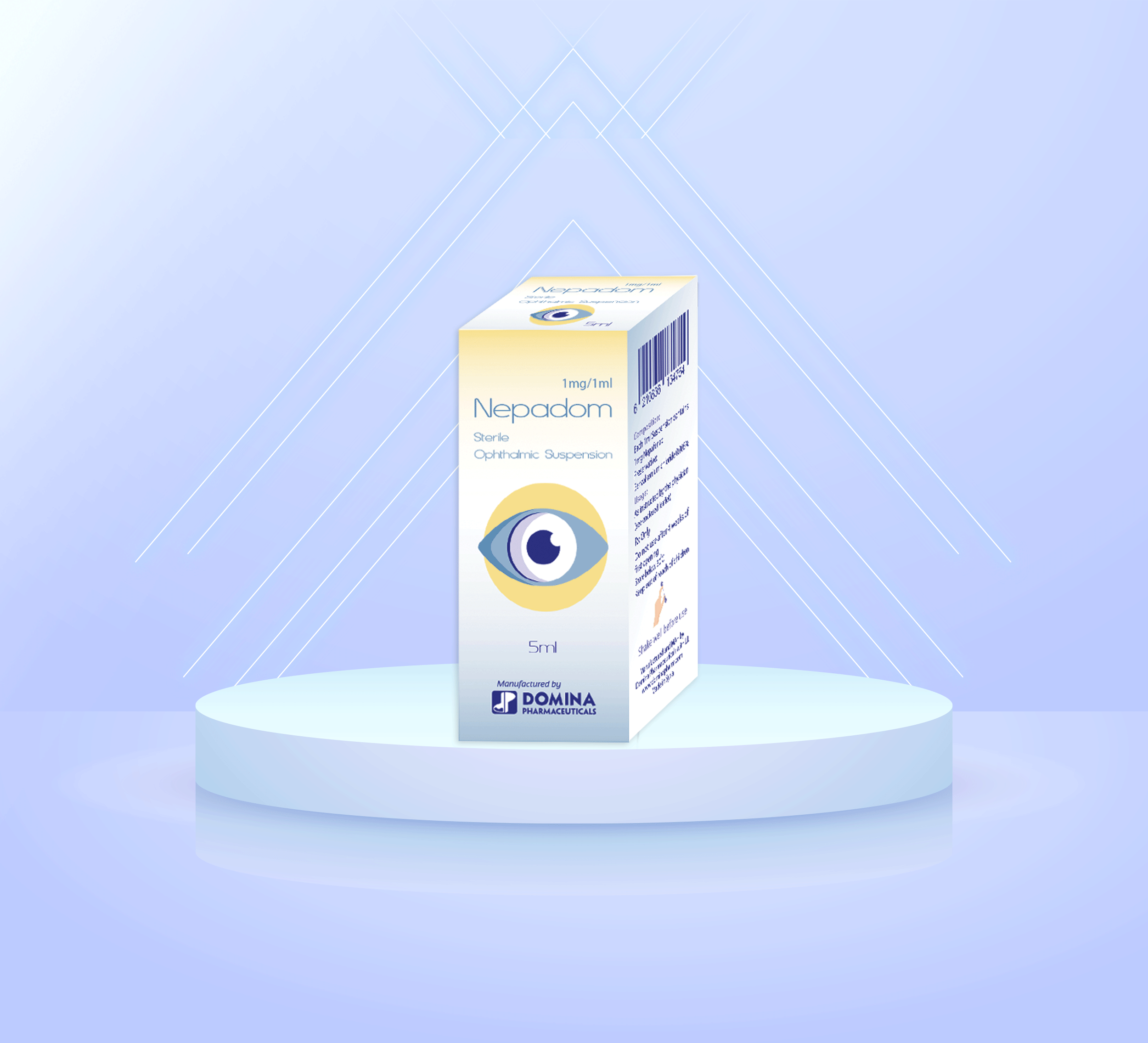
Composition:
Each 1ml sterile ophthalmic suspension contains 1mg nepafenac.
Mechanism of action:
After topical ocular dosing, Nepadom penetrates the cornea and is converted by ocular tissue hydrolases to amfenac, a nonsteroidal anti-inflammatory drug. Amfenac is thought to inhibit the action of prostaglandin H synthase (cyclooxygenase), an enzyme required for prostaglandin production.
Pharmacokinetic:
Low but quantifiable plasma concentrations of nepafenac and amfenac were observed in the majority of subjects 2 and 3 hours post dose, respectively, following bilateral topical ocular three-times-daily dosing of nepafenac ophthalmic suspension, 0.1%. The mean steady-state C for nepafenac and for amfenac were 0.310 ± 0.104 ng/ml and 0.422 ± 0.121 ng/ml, respectively, following ocular administration.
Indications:
Nepadom is indicated in treatment of pain and inflammation associated with cataract surgery.
Contraindications:
Nepafenac is contraindication if there is hypersensitivity to any of the ingredients in the formula or to other NSAIDS.
Dosage and administrations:
Shake the bottle well before use.
- One drop of Nepadom should be applied to the affected eye(s) three times daily beginning 1 day prior to cataract surgery, continued on the day of surgery and through the first 2 weeks of the postoperative period.
- Nepadom may be administered in conjunction with other topical ophthalmic, such as beta-blockers, carbonic anhydrase inhibitors, alpha-agonists, cycloplegics, and mydriatics.
- If more than one topical ophthalmic medication is being used, the medicines must be administered at least 5 minutes apart.
- The safety and effectiveness of nepafenac ophthalmic suspension in pediatric patients below the age of 10 years have not been established.
Warnings and Precautions:
Use of Nepafenac Ophthalmic Suspension may cause:
- Increased Bleeding Time:
With some nonsteroidal anti-inflammatory drugs including nepafenac, there exists the potential for increased bleeding time due to interference with thrombocyte aggregation. There have been reports that ocularly applied nonsteroidal anti-inflammatory drugs may cause increased bleeding of ocular tissues (including hyphemas) in conjunction with ocular surgery. It is recommended that nepafenac ophthalmic suspension be used with caution in patients with known bleeding tendencies or who are receiving other medications which may prolong bleeding time.
- Delayed Healing:
Topical nonsteroidal anti-inflammatory drugs (NSAIDs) including nepafenac, may slow or delay healing. Topical corticosteroids are also known to slow or delay healing. Concomitant use of topical NSAIDs and topical steroids may increase the potential for healing problems.
- Corneal Effects:
Use of topical NSAIDs may result in keratitis. In some susceptible patients, continued use of topical NSAIDs may result in epithelial breakdown, corneal thinning, erosion, ulceration or perforation. These events may be sight threatening. Patients with evidence of corneal epithelial breakdown should immediately discontinue use of topical NSAIDs including nepafenac and should be closely monitored for corneal health. Post marketing experience with topical NSAIDs suggests that patients with complicated ocular surgeries, corneal denervation, corneal epithelial defects, diabetes mellitus, ocular surface diseases (e.g., dry eye syndrome), rheumatoid arthritis, or repeat ocular surgeries within a short period of time may be at increased risk for corneal adverse events which may become sight threatening. Topical NSAIDs should be used with caution in these patients. Post marketing experience with topical NSAIDs also suggests that use more than 1 day prior to surgery or use beyond 14 days post-surgery may increase patient risk and severity of corneal adverse events.
- Contact Lens Wear:
Nepafenac ophthalmic suspension should not be administered while using contact lenses.
Undesirable effects:
Increased Bleeding Time, Delayed Healing, Corneal Effects.
Pregnancy:
Pregnancy Category C. Nepafenac should be used during pregnancy only if the potential benefit justifies the potential risk to the fetus.
Breast-feeding:
Nepafenac is excreted in the milk of lactating rats. It is not known whether this drug is excreted in human milk. Because many drugs are excreted in human milk, caution should be exercised when nepafenac ophthalmic suspension is administered to a nursing woman.